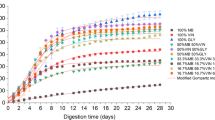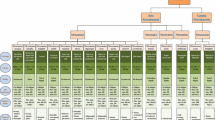Abstract
Methods for improving the anaerobic digestion of glycerol (propane-1,2,3-triol) were investigated, particularly the effects of using acclimated sludge as seeding material during start-up. Glycerol was supplied to the anaerobic digester at an organic loading rate of 2.5 g-COD L−1 day−1. Four experimental runs were carried out with varying mixing ratios of acclimated sludge to unacclimated sludge (0, 10, 20, and 33%). Calculations were performed by employing a numerical model, whose parameters were determined by experimental measurements. Methane production rate (MPR) for all runs attained similar stable values around 21.4 mmol L−1 day−1, though more time was required for attaining stable state of methane production with lower mixing ratios of acclimated sludge. The initial MPR calculated was proportional to the mixing ratio of acclimated sludge. Furthermore, molecular biological methods showed that the types of microorganisms observed in all runs were similar. These results indicate that the seeding with different mixing ratios of acclimated sludge did not affect the microbial consortia in the anaerobic digestion approaching stable state, but did affect the cell density of the useful microorganisms at the start of methane fermentation. Consequently, it was confirmed that at a higher mixing ratio of acclimated sludge, the start of methane production became more vigorous.





Similar content being viewed by others
References
Ajanovic A (2011) Biofuels versus food production: does biofuels production increase food prices? Energy 36:2070–2076
Johnston M, Holloway T (2007) A global comparison of national biodiesel production potentials. Environ Sci Technol 41:7967–7973
Balat M, Balat H (2010) Progress in biodiesel processing. Appl Energy 87:1815–1835
Daud NM, Abdullah SR, Hasan HA, Yaakob Z (2015) Production of biodiesel and its wastewater treatment technologies: a review. Process Saf Environ Prot 94:487–508
Yazdani SS, Gonzalez R (2007) Anaerobic fermentation of glycerol: a path to economic viability for the biofuels industry. Curr Opin Biotechnol 18:213–219
Viana MB, Freitas V, Leitão RC, Pinto GS, Santaella ST (2012) Anaerobic digestion of crude glycerol: a review. Environ Technol Rev 1:81–92
Dinh NT, Hatta K, Kwon SH, Rollon AP, Nakasaki K (2014) Changes in the microbial community during the acclimation stages of the methane fermentation for the treatment of glycerol. Biomass Bioenergy 68:240–249
Yang Y, Tsukahara K, Sawayama S (2008) Biodegradation and methane production from glycerol-containing synthetic wastes with fixed-bed bioreactor under mesophilic and thermophilic anaerobic conditions. Process Biochem 43:362–367
Vásquez J, Nakasaki K (2016) Effects of shock loading versus stepwise acclimation on microbial consortia during the anaerobic digestion of glycerol. Biomass Bioenergy 86:129–135
Suryawanshi PC, Chaudhari B, Bhardwaj S, Yeole TY (2013) Operating procedures for efficient anaerobic digester operation. Res J Anim Vet Fish Sci 1:12–15
Appels L, Baeyens J, Degrève J, Dewil R (2008) Principles and potential of the anaerobic digestion of waste-activated sludge. Prog Energy Combust Sci 34:755–781
Jain S, Wolf IT, Wah TY (2014) Anaerobic digestion of food waste using artificially cultured and natural anaerobes under Mesophilic conditions. J Mater Environ Sci 5:1709–1714
Sutherland AD, Varela JC (2014) Comparison of various microbial inocula for the efficient anaerobic digestion of Laminaria hyperborea. BMC Biotechnol 14:1–8
Vrieze JD, Raport L, Willems B, Verbrugge S, Volcke E, Meers E et al (2015) Inoculum selection influences the biochemical methane potential of agro-industrial substrates. Microb Biotechnol 8:776–786
Janeczko A, Oleszkiewicz JA (1993) Response of acclimated and un-acclimated activated sludge to 2-nitrophenol. Environ Technol 14:351–358
Nuchdang S, Khemkhao M, Techkarnjanaruk S, Phalakornkule C (2015) Comparative biochemical methane potential of paragrass using an unacclimated and an acclimated microbial consortium. Bioresour Technol 183:111–119
Nakasaki K, Kwon SH, Takemoto Y (2015) An interesting correlation between methane production rates and archaea cell density during anaerobic digestion with increasing organic loading. Biomass Bioenergy 78:17–24
Kwon SH, Nakasaki K (2014) Relationship between changes in microbial community and the deterioration of methane fermentation which treats synthetic peptone wastewater. J Ind Eng Chem 21:443–450
Gerardi M (2003) The microbiology of anaerobic digesters. Wiley, New Jersey
Golueke CG (1977) Biological reclamation of solid waste. Rodale press, Emmaus
Nakasaki K, Araya S, Mimoto H (2013) Inoculation of Pichia kudriavzevii RB1 degrades the organic acids present in raw compost material and accelerates composting. Bioresour Technol 144:521–528
Nakasaki K, Mimoto H, Tran QNM, Oinuma A (2015) Composting of food waste subjected to hydrothermal pretreatment and inoculated with Paecilomyces sp. FA13. Bioresour Technol 180:40–46
Nakasaki K, Matsuura H, Tanaka H, Sakai T (2006) Synergy of two thermophiles enables decomposition of poly-ε-caprolactone under composting conditions. FEMS Microbiol Ecol 58:373–383
Acknowledgements
We are grateful with Dr. Michiharu Abe and the members of Nakasaki laboratory for their constant support and comments. This research did not receive any specific grant from funding agencies in the public, commercial, or not-for-profit sectors.
Author information
Authors and Affiliations
Corresponding author
Rights and permissions
About this article
Cite this article
Vásquez, J., Nakasaki, K. Effects of acclimated sludge used as seeding material in the start-up of anaerobic digestion of glycerol. J Mater Cycles Waste Manag 20, 185–192 (2018). https://doi.org/10.1007/s10163-016-0560-6
Received:
Accepted:
Published:
Issue Date:
DOI: https://doi.org/10.1007/s10163-016-0560-6




